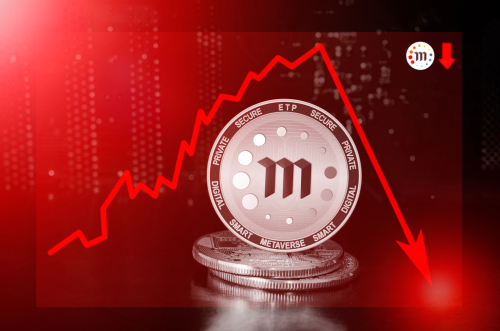

Bitcoin had been rallying since we received a hotter-than-expected CPI print (8.2% vs. 8.1% expected) for September on Thursday last week. But crypto markets have cooled this week, giving back some of those gains. Bitcoin opened the week fairly strong at around $19,250 before rallying to weekly highs of around $19,700 on Tuesday. Since then, bitcoin sold off to weekly lows of around $18,900 yesterday. As we approach the end of the week, it continues to trade in a range between $18,900 and $19,300.
This article is only available to Macro Hive subscribers. Sign-up to receive world-class macro analysis with a daily curated newsletter, podcast, original content from award-winning researchers, cross market strategy, equity insights, trade ideas, crypto flow frameworks, academic paper summaries, explanation and analysis of market-moving events, community investor chat room, and more.
Bitcoin had been rallying since we received a hotter-than-expected CPI print (8.2% vs. 8.1% expected) for September on Thursday last week. But crypto markets have cooled this week, giving back some of those gains. Bitcoin opened the week fairly strong at around $19,250 before rallying to weekly highs of around $19,700 on Tuesday. Since then, bitcoin sold off to weekly lows of around $18,900 yesterday. As we approach the end of the week, it continues to trade in a range between $18,900 and $19,300.
Crypto Volatility at Multi-Year Lows
Volatility has been decreasing with many cryptocurrencies trading in a tight range for a while now. Bitcoin has spent most of this month trading in a range between around $18,500 and $20,500. The obvious exception was the increased volatility we saw around the CPI release on Thursday last week.
Zooming out, the rolling 30-day annualised volatility for bitcoin (around 25%) is the lowest it has been since July 2020. It is even more evident for ethereum, whose current rolling 30-day annualised volatility (around 31%) is the lowest it has been since February 2017. Furthermore, bitcoin has recently become less volatile than some of the traditional equity indices it spent much of this year highly correlated to. Indeed, the 30-day annualised volatility for the NASDAQ and the S&P 500 are currently around 32% and 28%, respectively.
The Macro Backdrop Is Still Bearish
The reduced volatility of bitcoin and other major cryptocurrencies is partly due to a broader drop in trading volume across the space. But there is also the macro backdrop, which has been bearish ever since the Federal Reserve (Fed) started hiking interest rates to try and tame inflation.
While bitcoin’s correlation to equities has been declining recently, we still see large swings in its price around key macro data releases like CPI and payrolls. This confirms macro factors are still affecting crypto markets, and any sign of dovishness from the Fed would most likely be the catalyst buyers in waiting need to start taking long positions again and bring trading volumes back up.
As it stands, the latest Fed minutes were still Hawkish and show a Fed pivot is nowhere near. Additionally, Dominque still expects a terminal rate near 8% with 75bp hikes in November and December. The macro backdrop remains bearish for crypto.
Performance of Our Indices
As for our various indices, our Smart Contract index (-5% Wow) and our Metaverse index (-7% WoW) are down the most while our Bitcoin index (-2% WoW) and Privacy Index (-1% WoW) are down the least (Charts 1 and 2). Meanwhile our DeFi index is flat.
Our Metaverse (80%) and Privacy (78%) indices are correlated most to bitcoin, while our (72%) and DeFi (72%) indices are correlated least to bitcoin (Chart 3). On macro markets, bitcoin’s correlation to tech stocks drops again while its correlation to gold remains elevated at 45% and its correlation to oil jumps to 61% (Chart 4). Elsewhere, its correlation to 10Y yields has collapsed to 0%.
- Smart Contract Platform Index: EOS (EOS) is up the most (+2% WoW) and Terra Luna Classic (LUNC) is down the most (-15% WoW). Ethereum is down 1%.
- DeFi Index: Maker (MKR) is up the most (+15% WoW) and Terra Luna Classic (LUNC) is down the most (-15% WoW)
- Metaverse Index: The Virtua Kolect (TVK) is up the most (+4% WoW) and Ultra (UOS) is down the most (-18% WoW).
- Privacy Index: Beam (BEAM) is up the most (+4% WoW) and Keep Network (KEEP) is down the most (-7% WoW).
- Bitcoin: this is down 2% WoW.


What Are in the Four Indices?
Here are the indices in more detail:
- Bitcoin: the OG of crypto markets deserves its own category and is in many ways the true benchmark for any other crypto market.
- Smart contract platforms: after bitcoin, the big innovation was to have blockchains that were more programmable. These could host smart contracts or decentralised applications and have allowed the emergence of the metaverse and defi. Ethereum (ETH) is the most popular version of a smart contract platform. As well as ethereum, we also include some key competitors. The constituents of this index are: Ethereum (ETH), Cardano (ADA), Avalanche (AVAX), Solana (SOL), Fantom (FTM), VeChain (VET), Terra (LUNA), EOS (EOS), and Chainlink (LINK). We also include Polkadot (DOT) which allows interoperability between blockchains and the use of smart contracts via parachains.
- Metaverse: coins associated with the creation of a virtual space/digital world on the internet using a combination of augmented reality, virtual reality, and social networks. The constituents of this index are Axie Infinity (AXS), The Sandbox (SAND), Decentraland (MANA), Enjin Coin (ENJ), Aavegotchi (GHST), Terra Virtua Kolect (TVK), Ultra (UOS), Phantasma (SOUL), RedFOX Labs (RFOX), and Gala (GALA).
- Decentralised Finance (DeFi): financial services built on top of blockchain networks with no central intermediaries. This can be a broad category, so we narrow this down to platforms that focus on lending/borrowing, yield farming, automated market making and decentralised exchange tokens. The constituents of this index are: Aave (AAVE), Compound (COMP), Uniswap (UNI), Yearn.finance (YFI), Loopring (LRC), PancakeSwap (CAKE), Maker (MKR), 1inch (1INCH), Thorchain (RUNE), and Terra (LUNA).
- Privacy Coins: coins that obscure transactions on the blockchain to maintain the anonymity of its users and their activity. The constituents of this index are Monero (XMR), Zcash (ZEC), Dash (DASH), Verge (XVG), Horizen (ZEN), Beam (BEAM), Secret (SCRT), Decred (DCR), Keep Network (KEEP), and Dusk Network (DUSK).
Dalvir Mandara is a Quantitative Researcher at Macro Hive. Dalvir has a BSc Mathematics and Computer Science and an MSc Mathematical Finance both from the University of Birmingham. His areas of interest are in the applications of machine learning, deep learning and alternative data for predictive modelling of financial markets.
Bilal Hafeez is the CEO and Editor of Macro Hive. He spent over twenty years doing research at big banks – JPMorgan, Deutsche Bank, and Nomura, where he had various “Global Head” roles and did FX, rates and cross-markets research.
